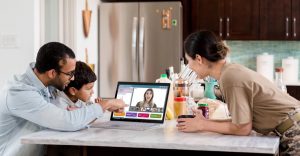Vignette 1: Listen to Learn

Setting the Scene: Today is a remote instruction day. This example highlights a synchronous learning opportunity in which the student is being supported from home. This family has questions and suggestions for the teacher. The child’s parents are reluctant to share feedback.
Tactic: Foster two-way communication.
- Thank families for their support and encourage dialogue through outreach and vulnerability.
Providing a safe space: Providing a safe space that encourages dialog through outreach and vulnerability will create stronger relationships with families as partners. In order to listen to learn, ensure consistent feedback routines are implemented, families are intentionally involved, and that as the educator, you take the time to listen and respond appropriately.
Research shows, when you take the time to listen, it makes a big impact on relationships with students and families. Remember, a family can be mom and dad, brothers or sisters, grandparents, aunts and uncles, caregivers, day care providers, or anyone who is supporting student learning in a remote or hybrid environment.
- Seek to understand, then to be understood: When we take time to really listen, it makes a big impact on relationships with students and families.
- Foster two-way communication: Two-way communication is critical to increasing parent involvement and positive relationships.
- Appreciate the partnership: Build partnerships through communication, fostering involvement, and appreciation.
Listening to learn requires an educator to build time into learning opportunities. One way to attain feedback and to check for understanding is to have students reflect and then share suggestions or questions with you and the class. Using a three step process, students are instructed to engage in independent thinking, initiate a signal to the teacher when they have completed the exercise, and then volunteers are invited to share out with the group. Helpers can be asked to engage in this practice too.
- Reflect and brainstorm
- Thumbs-up when you are done
- Share one thing with the class.
References: Supporting Teaching and Learning at Home
Vignette 2: Parents as Partners

Setting the Scene: Today is a remote instruction day. This example highlights a synchronous or asynchronous learning opportunity in which the student is being supported from home.This mom is wondering how much to assist her son with this project.
Define the Team: Provide families with guidance regarding how they can assist students. Concrete suggestions help the team understand roles.
It can be challenging for those supporting learners to know how much help they should or should not provide. To partner with parents or caregivers take the time to provide guidance with concrete suggestions as to how they can best support younger and older children.
- Provide younger children with support and redirection
- Provide older children with clear expectations, and get out of the way
Research shows when families are involved with school, there is a positive impact on student achievement.
- Consider the lift for parents: Consider how to best cultivate a partnership. It can be difficult for families to help with certain content.
- Personalize the partnership: Not all families are able to support remote learning the same way. Educators must be flexible and adapt based on families’ needs.
Help families upgrade their practices:
- Instead of reviewing my child’s writing and writing corrective notes, I can sit with my child, ask questions and offer suggestions.
- Instead of providing praise that sounds like “You are so smart!”, I can provide praise that sounds like “You are working hard!”
- Instead of saying “Math is hard. I am not very good at it either,” I can say, “You will improve with practice. How can I help?”
- Instead of reading with my child and stating the correct way to read words, I can say, “Skip that, we can come back,” and let them try again.
- Instead of complimenting the product by saying, “You got that right,” I can compliment the process and persistence.
References: Supporting Teaching and Learning at Home
Vignette 3: Healthy Home Habits

Setting the Scene: Today is a remote or hybrid instruction day. This example highlights an asynchronous learning opportunity in which the student is being supported from home or a student is being supported before or after attending school. This student and/or her family members might experience stress during this time of extended school closure.
Model and promote wellness: Wellness challenges have increased during the pandemic. Partner with colleagues to offer additional emotional and physical wellness supports.
Leverage special area experts: Special area educators and some district leaders have a specialized skill set that can be leveraged to support parents in knowing how to develop and maintain healthy habits at home.
Encourage fitness, nutrition, rest and balance: In order to promote healthy habits at home, educators can support family partnerships by offering emotional and physical wellness supports. For example, a school lunch director can provide resources to support nutrition at home.
To support healthy habits at home, a focus on non-academic needs should be addressed. Nutrition is just one such need.
Intentional social-emotional learning: Social emotional learning must be intentionally addressed to support the well-being and success of students, staff, and families.
Focus on the whole child: Consider students’ non-academic needs. For example, a successful nutrition program is critical. Children cannot focus on learning when they are hungry.
As an educator, a My Plate Pledge is an easy activity to include in a weekly learning plan for students and will encourage families to partner in supporting healthy habits at home.
References: Supporting Teaching and Learning at Home
Vignette 4: Organizational and Study Skills

Setting the Scene: Today is a remote instruction day. This example highlights an asynchronous learning opportunity for a student working alone from home. The dad works outside the house during the day. He knows the teen is struggling with some elements of the remote learning environment.
Encourage Learning Routines: Students benefit from structure and consistency. Provide students and families with suggested organizational routines.
Implement consistent tools: Consistent tools across departments, grade levels, and/or school buildings, that can be easily accessed in a central location, like on a school website, are quick wins for supporting learner independence.
When a student knows where to access support resources, they are one step closer to being successful. In order to encourage independence for learners, educators can provide resources to students which support them with scheduling, time management, and organizational strategies.
Research shows independent learners develop life skills which will benefit students in the future including resiliency and problem solving skills.
Develop executive function skills: Educators and families should foster the development of executive functioning skills (managing time, resources, and attention) in middle school. Adults can support students by helping them build awareness of issues and assisting them in implementing skills to address weakness.
Support resiliency and problem-solving: Don’t focus on preventing failure. Through failure, children learn resiliency and problem solving.
To encourage independent learners, consider providing students with graphic organizers and planning resources. For example, students can use a planning resource to develop goals for the month to help them stay on track and own their learning, or they can use a task list to help them prioritize assignments and activities.
References: Supporting Teaching and Learning at Home
Vignette 5: Accessible Educators
Setting the Scene: Today is a remote instruction day. This example highlights a synchronous or asynchronous learning opportunity for a student who may or may not be working from home alone. This student is independently working through an assignment. She gets stuck. She isn’t sure how to best approach a task. After looking back in her notes and skimming her textbook, she realizes she would benefit from teacher support. She signs up for a slot during her teacher’s office hours.
Encourage students to seek help: Encourage students to reflect, identify needs, and seek help using a variety of strategies and support structures.
As students learn to be independent learners, or even if they have not mastered this skill yet and rely on a helper to keep them on track and focused when learning remotely, being accessible to students and families alike is key as an educator.
Develop plans to support small group and one-on-one needs: If you are struggling to be there for each student individually, consider developing small group meetings to support student needs.
Provide students with tools that support student-to-teacher outreach: Provide an electronic means for students to seek help from you, like through the completion of an online request form, using a messaging application, or emailing you for assistance.
Research shows independent learners develop life skills which will benefit students in the future including resiliency and problem solving skills.
Teach strategies to support independence: Do not depend on parents to help students get “unstuck” if they have a question, make an error, or do not know what to do next.
Offer office hours and check-in conferences: To support relationship building and student learning, implement virtual office hours and check-in conferences with families and students.
An educator is not always going to be available to a student or family when the learning is occurring remotely. What about if a student has a need at 10 p.m. on a Wednesday night. Or on a Sunday afternoon? Consider establishing an “I’m Stuck” checklist. It is kind of like “ask 3 and then me.” This action might help a student or family find the answer they need, when you are not available. It will keep the learning going and support families as partners.
References: Supporting Teaching and Learning at Home
Vignette 6: Tactical Touchpoints
Setting the Scene: Today is a remote or hybrid instruction day. This example highlights a synchronous or asynchronous learning opportunity the student is encountering alone. The student typically drives to school or is dropped off. Remote learning makes it less clear to his parents when he is “at school.” His family appreciates his school’s communication related to attendance and grades.
As educators, regular communication about student attendance and engagement concerns is a means of creating tactical touchpoints with families. Also, remember to communicate positive attendance and engagement information as well.
Keep parents informed: Foster regular communication about student attendance and engagement using technology, text, and/or mail. Provide specific information. Personalize communication to families when students are absent. Recognize good and improved attendance.
Best practices to support tactical touchpoints with families, especially when attendance or engagement is a challenge, include the creation of individualized attendance plans or scheduling virtual meetings to discuss attendance and engagement.
Proactively establish amicable relationships: Families should not only hear from the school when something is wrong. Build trust by proactively establishing relationships.
Implement virtual family meetings: Schedule virtual family meetings to support chronically absent students. Develop individualized attendance plans with families and students.
In many instances, remote learning is new for students. Some families and students don’t know what steps they need to implement to have positive attendance and engagement in a remote setting. An attendance improvement plan can be as simple as a checklist of actions to support student success. Developing this plan in partnership with the student and their family is a great way to create a network of support in a remote or hybrid learning setting.
References: Supporting Teaching and Learning at Home
Vignette 7: Organize and Adapt

Setting the Scene: Today is a remote instruction day. This example highlights a synchronous or asynchronous learning opportunity in which the student is being supported in or working alone from home. At school, her teacher helps her keep her space organized and assists her in having the correct materials for each lesson. :
Encourage home organization: Provide students and families with guidance related to the organization of the learning environment and materials.
Define expectations to maximize learning and minimize distraction: In order for organization of the learning environment to be possible for families, it is important that an educator define the expectations, but then also be ready to adapt when those expectations can not be met. For example, an educator might want the student to have a designated space for remote learning; however, if a student does not have access to a single location like a table or room of a home, be ready to be flexible with a student and encourage them to even find a corner of a room, end of a shared table, or side of the couch that they can call their own for remote learning.
Research shows that teachers who support students in establishing an organized learning environment in turn are able to maximize student learning.
Teach procedures and routines: Teachers organize students, space, time, and materials to maximize student learning.
Translate norms to the virtual space: Adjust the norms you would use in a regular classroom to work in a virtual space.
Consider creating a back to school ready checklist for your students. If you are halfway through the school year, consider sending this list out again to students. It is amazing how resources get misplaced or used up before the end of the school year, but isn’t that the purpose of having them?
References: Supporting Teaching and Learning at Home
Vignette 8: Strategic Selections
Setting the Scene: Today is a remote or hybrid instruction day. This example highlights a synchronous or asynchronous learning opportunity in which the student is being supported or working alone from home.Schools leverage numerous digital and paper-based instructional tools. Sometimes teens feel overwhelmed by a full “book bag” (and suite of digital tools).
Standardize resources: Deploy a limited number of paper and digital instructional resources.
There is a plethora of instructional tools educators can access to support student learning; however, when it comes to instructional tools, the kitchen sink approach can be hard for families as partners to manage. Consider creating as much standardization as possible, so learning partners have fewer tools to learn how to use.
Communicate critical information to support students and families in effectively using district tools: Ensure families know how to get support with the instructional tool if needed. Don’t let the tool hinder or be the barrier to the learning process.
Remember to focus on the learning and not the tool. Every instructional software is going to have its pros and cons. As the educator, you are the content-area expert.
Instructional tools can take on many shapes and sizes. Instructional tools can be physical resources like textbooks, books, or manipulatives. In a remote or hybrid learning environment, instructional tools often take on digital attributes. These are just some of the student technology tools you might be leveraging in your traditional or virtual classroom. For the best home-to-school partnership, ensure families know which tools are being used by communicating information about the priority tools in a clear and concise manner.
Focus on effectiveness and usefulness: Focus on learning engagement rather than the tools.
Use a consistent and limited set of tools: Technology tool choices should be limited and consistent. Teachers, students, and families can be overwhelmed by too many tools.
Manage expectations related to software: Softwares have strengths and weaknesses. Establish realistic expectations related to softwares.
References: Supporting Teaching and Learning at Home
Vignette 9: Proactive Planning
Setting the Scene: Today is a remote or hybrid instruction day. This example highlights a synchronous or asynchronous learning opportunity in which the student is being supported from home or working alone. At the start of the COVID-19 pandemic, the district did not have information about students’ access to internet and devices at home. The district’s immediate actions included surveying families and making district devices available. The district is now developing a long-term plan to address the digital divide.
Enhance technology plans: To close the digital divide, develop strategic and sustainable home IT plans. Students must have equitable access to devices and Internet.
In order to proactively plan, it is important to collect current instructional technology (IT) needs a student might have or a family might need in order to support student learning remotely. Surveying families regularly is an important first step in the planning process.
Through the collection of survey data, it is known that there are technology access inequities across NYS. Try to manage family frustration and strive to provide access to all. Strategies to support internet access to all learners might be providing WIFI on buses or boosting WIFI signals to parking lots. As an educators, you might not be able to directly implement these actions, however, you can communicate alternative internet options available in your district to families and recognize the challenges families might face and be flexible and understanding to their troubles.
Provide students with devices and internet: Schools should strive to provide students with devices and reliable internet for use at home.
Implement the best solutions: Internet is not equitably accessible across NYS. When districts can’t provide home solutions, implement alternatives. For example, boosting Wi-Fi signals to parking lots.
Manage expectations related to software: Minimize frustration by preparing stakeholders for technology problems.
Remember to focus on the learning and not the tool. Every instructional software is going to have its pros and cons. As the educator, you are the content-area expert.
References: Supporting Teaching and Learning at Home
